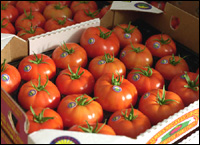Dear Umbra,
What are the advantages of hydroponics, and if it is so good, why isn’t it used more?
Luke
Mitchellville, Iowa
Dearest Luke,
Plants take up most of their nutrients through their roots, despite all we learned in elementary school about leaves making food from the sun. Soil is a complex conglomeration of minerals, nutrients, bugs, and fungi that deliver nutrients to plants via the root system. Farmers and gardeners labor to stuff their soil with the perfect blend of nutrients for each plant.

Look ma, no soil!
Photo: National Renewable Energy Laboratory.
Hydroponics grew out of the logical idea that it might be easier and more effective to deliver nutrients directly to plant roots. Although hydroponics has been practiced for thousands of years in various forms, the modern incarnation of the industry appeared in the 1920s and developed over the 20th century in tandem with the development of plastics and highly soluble synthetic fertilizers.
Today, hydroponics is understood to mean any type of soilless propagation, including plants floating in water and plants in a sterile gravel bed soaked with water. Roots are fed with aqueous solutions calibrated to bring each plant the perfect diet and maximize crop output. The solutions are recycled or discarded, depending on the system. Growing conditions for successful hydroponics must be strictly monitored and controlled — hence the dominance of greenhouse-based hydroponics.
If you live in a location with little or no living soil, the primary advantage of hydroponics is the ability to grow vegetables at all. U.S. troops grew vegetables on barren Pacific islands in WWII, for example. The other advantages of hydroponic cultivation mainly center on the ability to closely control growing conditions and nutrient availability.
I spoke with Farmer W., who has a small operation and uses hydroponics as one growing technique. He raved about the accelerated production, which in farmspeak means that he has earlier and more crops than his market competition. He doesn’t get higher prices for hydroponic tomatoes, but he has more of them sooner, giving him an advantage.
Expense is an obvious disadvantage. Even with the advent of relatively cheap and easy-to-assemble plastic greenhouses, plastic piping, plastic growing tanks, beds, and cells, and the ready availability of soluble nutrients, it’s still darn expensive to run a greenhouse operation. In aggregate, it can take less energy to grow and truck in soil-grown tomatoes from Mexico than to grow them hydroponically in Ohio.
I don’t know if hydroponics is “so good.” They’re fine, certainly, and a great addition to a mixed-crop small farm, good for greenhouse production of herbs and other plants. As to why the technique isn’t used more widely, well, it’s capital- and technology-intensive, and to boot, it’s not trendy yet. Farmer W.’s hydroponic greenhouse blew over in a winter windstorm, so that’s a pain in the neck. Also, vegetables are legal to grow and consume. If veggies were illegal, the price would be driven up on the underground market, and it would be worth the expense of hydroponic cultivation.
Incidentally, hydroponics is perfect for an indoor growing operation that can’t be seen from the air. I’d venture to guess that hydroponics is used quite widely in a certain sector of plant cultivation, if you get my drift.
Hotly,
Umbra

